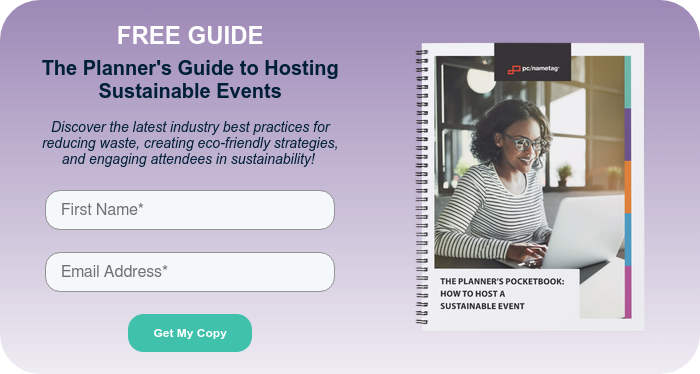Many nonprofit organizations set specific sustainability goals or make pledges to reduce their carbon footprint, even when their mission does not directly relate to sustainability or conservation. Promoting environmentally friendly practices demonstrates your organization’s core values, enhances its reputation, reduces costs, and betters the local environment.
While well-intentioned, these pledges don’t always translate into action. That’s why it’s crucial to prioritize sustainability in every aspect of your operations, from event planning to donor communications.
In this guide, we’ll cover tips for integrating eco-friendly practices into your nonprofit events that go beyond the basics (e.g., setting out recycling bins). Stay tuned until the end to explore an interactive scorecard you can use to grade your event.

Considering the Entire Event Lifecycle
To truly reduce your events’ impact, sustainability can’t just be an afterthought. For example, going paperless requires deliberate planning.
To make this vision a reality, you would likely need to create digital versions of your paper forms, select tools like online invitation or waiver software to support the new initiative, and build a new email list of recipients.

See how you can weave sustainability into each phase of event planning:
1. Before the Event: Planning and Strategy
During this phase, you’ll need to embed eco-friendly thinking into your decision-making to implement intentional changes. In addition to mistakes like neglecting sustainability until later in the planning process, nonprofits may err by choosing vendors based on price or convenience only, or defaulting to unsustainable practices out of habit or tradition.
To combat these common pitfalls, consider:
- Setting specific sustainability goals. Set SMART goals, or objectives that are Specific, Measurable, Achievable, Relevant, and Time-bound. For example, perhaps you want to use zero plastic or reduce food waste by 75%. From here, build a plan to help you achieve these goals.
- Supporting sustainable local businesses whenever possible. Not only do smaller-scale operations typically have shorter supply chains and a smaller ecological footprint than big corporations, but you’ll also be directly supporting the local economy.
- Going paperless. Reduce paper waste by using digital invitations, forms, or programs. These alternative formats often have benefits beyond just being eco-friendly. For example, say your nonprofit requires waivers for any charity race participants. As Smartwaiver’s guide
explains, digital waivers are also more cost-effective, convenient, secure, and easier to use.
2. During the Event: Execution and Engagement
This phase entails the on-site experience. This is where all of your planning, preparation, and sustainable decision-making become visible. Look out for missteps like neglecting to provide compost or recycling bins, using only single-use utensils and decor, and failing to educate attendees and staff. Instead, execute your event by:
- Using green event supplies. If you need to source new items for your event, look into sustainable options like recyclable event badges, lanyards made from recycled bottles, or biodegradable badge ribbons.
- Training staff and volunteers. Empower your staff and volunteers to champion sustainability. You might designate a specific team of “green guides” who monitor and assist at waste stations, educate attendees on green practices, promote sustainable practices (e.g., returning badges), and document their observations.
- Making smart switches. For example, provide reusable water bottle refill stations or offer digital kiosks attendees can use to complete online forms. Look for clever ways to reuse past event materials (e.g., using leftover merch as raffle prizes or repurposing generic signage). If you’re holding the event at your facility, consider switching to energy-efficient lighting.
3. After the Event: Tear Down and Follow-Up
Once your event wraps up, there are still a few key steps you’ll need to tackle to measure your event’s performance and maintain consistent contact with attendees. In addition to avoiding print communications, your nonprofit can further embrace sustainability during this stage by:
- Having a plan for leftover items. If you don’t have a plan for leftover food, signage, merchandise, or other event materials, it’s easy for reusable or recyclable items to end up in the trash. Identify sustainable options ahead of time, like having attendees leave nametags in recycling bins when they exit, or planning to donate any remaining nonperishable food.
- Sending digital thank-you letters. Consider alternatives to paper letters, such as digital eCards. You’ll still be able to connect with attendees and express your gratitude, but, as eCardWidget explains, eCards allow you to reach them more efficiently, incorporate extensive customization, and even add interactive elements.
- Sharing sustainability results. Track and report on the success of these initiatives to highlight the positive environmental impact. Calculate metrics like pounds of waste diverted or recycled, and create infographics to communicate impact visually. Share with attendees and other stakeholders via email or social media.
Green Event Scorecard
Use this interactive event scorecard to grade your event. You can score your event in real-time as you move through each phase, or even score past events to identify areas for improvement. For each item you check off, you’ll receive one point.
Event Planning
☐ Our venue is in a walkable or transit-friendly location, and we encourage these modes of transportation.
☐ We use digital outreach pre-event engagement materials like email invites and digital flyers.
☐ We’re working with local businesses that prioritize sustainability.
☐ Our vendors use compostable or recyclable packaging.
☐ We reuse leftover swag and signage, and/or we are creating sustainably sourced custom merch.
Event Execution
☐ Water refill stations are available, and we’re using reusable tableware or recyclable/compostable plates and cutlery.
☐ We offer clearly labeled recycling and/or compost bins.
☐ We use natural or energy-efficient lighting where possible or promote energy efficiency in other ways (e.g., smart thermostat programming).
☐ We established water tracking systems to measure and report on waste diversion.
☐ We’ve designated volunteers to serve as “green guides” or ambassadors for our sustainability efforts.
Post-Event Wrap-Up
☐ We’re tracking and reporting on sustainability metrics to attendees and other stakeholders.
☐ We donate leftover food, supplies, etc., to other nonprofits, mutual aid groups, etc.
☐ We’re following up with attendees via digital channels to limit paper usage.
☐ We’ve analyzed our performance and identified opportunities to improve the next event.
☐ We reached our sustainability goal or accomplished another sustainable objective (e.g., offsetting event emissions, reducing plastic use compared to previous years).
Scoring Guide
Here’s a breakdown of what your score means (and recommended next steps):
- 0-5 points: You’re just getting started! Focus on securing a few easy wins, like reusing signage or setting up recycling bins.
- 6-10 points: You’re making great progress. Make sure to document your processes so you can easily replicate them, and aim to incorporate at least one or two new initiatives at each event.
- 11-15 points: Congratulations! You’re pulling off sustainable, eco-friendly events! Keep doing what you’re doing, regularly look out for new ways to boost sustainability, and consider offering mentorship to other organizations.

As you plan your sustainable event, some changes might feel small and even insignificant. However, these adjustments have a bigger impact than you might think.
Consider the impact of switching from paper forms to digital ones when multiplied over dozens of events and hundreds of attendees; that small action ends up making a big difference.
Prioritize sustainability at every level of your operations to bring your nonprofit’s values to life by implementing changes that protect and steward the environment.




Submit a Comment